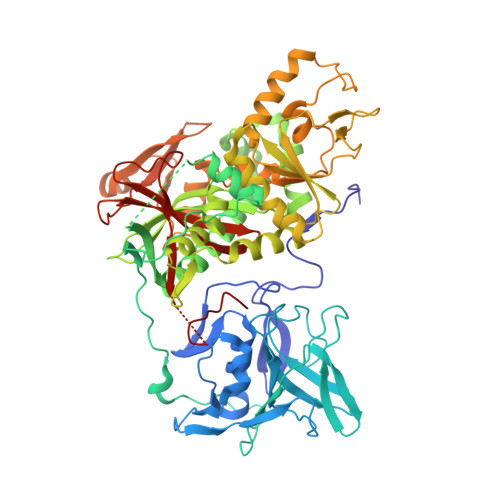Leishmania Trypanothione Synthetase-Amidase Structure Reveals a Basis for Regulation of Conflicting Synthetic and Hydrolytic Activities.
Fyfe, P.K., Oza, S.L., Fairlamb, A.H., Hunter, W.N.(2008) J Biol Chem 283: 17672
- PubMed: 18420578
- DOI: https://doi.org/10.1074/jbc.M801850200
- Primary Citation of Related Structures:
2VOB, 2VPM, 2VPS - PubMed Abstract:
The bifunctional trypanothione synthetase-amidase catalyzes biosynthesis and hydrolysis of the glutathione-spermidine adduct trypanothione, the principal intracellular thiol-redox metabolite in parasitic trypanosomatids. These parasites are unique with regard to their reliance on trypanothione to determine intracellular thiol-redox balance in defense against oxidative and chemical stress and to regulate polyamine levels. Enzymes involved in trypanothione biosynthesis provide essential biological activities, and those absent from humans or for which orthologues are sufficiently distinct are attractive targets to underpin anti-parasitic drug discovery. The structure of Leishmania major trypanothione synthetase-amidase, determined in three crystal forms, reveals two catalytic domains. The N-terminal domain, a cysteine, histidine-dependent amidohydrolase/peptidase amidase, is a papain-like cysteine protease, and the C-terminal synthetase domain displays an ATP-grasp family fold common to C:N ligases. Modeling of substrates into each active site provides insight into the specificity and reactivity of this unusual enzyme, which is able to catalyze four reactions. The domain orientation is distinct from that observed in a related bacterial glutathionylspermidine synthetase. In trypanothione synthetase-amidase, the interactions formed by the C terminus, binding in and restricting access to the amidase active site, suggest that the balance of ligation and hydrolytic activity is directly influenced by the alignment of the domains with respect to each other and implicate conformational changes with amidase activity. The potential inhibitory role of the C terminus provides a mechanism to control relative levels of the critical metabolites, trypanothione, glutathionylspermidine, and spermidine in Leishmania.
Organizational Affiliation:
Division of Biological Chemistry and Drug Discovery, College of Life Sciences, University of Dundee, Dow Street, Dundee DD1 5EH, United Kingdom.
















